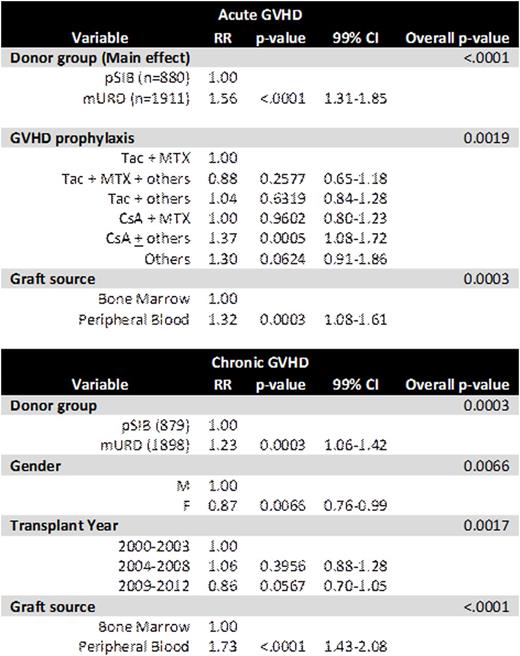Abstract

Introduction:
Optimal donor selection is critical to reduce morbidity and mortality from allogeneic hematopoietic cell transplant (HCT). HLA identical female parous sibling donors (pSIB) confer an increased risk of chronic graft vs. host disease (cGVHD) compared to male sibling donors, possibly from alloimmunization and exposure to fetal antigens during pregnancy. Unrelated donors (URD) also confer higher GVHD risk than sibling donors. While both pSIB and URD donors confer increased GVHD risk, they have never been directly compared. This study compares incidence of acute GVHD (aGVHD), cGVHD, survival, and treatment- related mortality in patients who received transplants from pSIB donors to male unrelated donors (mURD).
Methods:
A retrospective cohort study was completed using the Center for International Bone Marrow Transplant Registry (CIBMTR). We identified patients with acute myeloid leukemia (AML), acute lymphoblastic leukemia (ALL), or myelodysplastic syndrome (MDS) who underwent a non-T cell depleted HCT from an HLA identical pSIB or a matched mURD between 2000-2012. Recipients were at least 25 years at time of transplant to ensure female sibling donors had biological opportunity to become parous. Primary outcome was Grade II-IV aGVHD, cGVHD, and overall survival (OS). Secondary outcomes were relative risk (RR) of leukemia free survival (LFS), transplant related mortality (TRM) and relapse.
Results:
We identified 892 pSIB donors and 1921 mURD donors. Median recipient age at transplant was 49 (pSIB) and 50 (mURD), p=0.14. Median donor age was higher in pSIB than mURD (48 vs. 32, p<0.001). Cumulative incidence of aGVHD was higher in mURD than pSIB at 100 days, 46% vs. 35%, p<0.001. Incidence of cGVHD at 100 days was also higher in mURD (9% vs. 4%, p<0.001), but was not different at 1 year (mURD 50%, pSIB 50%, p=0.99) or 2 years (mURD 56%, pSIB 56%, p=0.77). In multivariate analysis adjusting for other risks of GVHD (prophylaxis, graft source, gender, and transplant year), mURD had a 1.6 times higher risk of grade II-IV aGVHD (p<0.0001) and 1.23 times higher risk of cGVHD (p=0.0003) than pSIB donors (Table 1).
A greater proportion of pSIB recipients were alive at 100 days (88% vs. 82%, p<.001), 1 year (62% vs. 57%, p=0.02), and 2 years (51% vs. 47%, p=0.02). However, in multivariate analysis donor type did not significantly affect OS (RR mURD 1.10, p=0.072), LFS (RR mURD 1.04, p=0.47), TRM (RR mURD 1.04, p=0.59), or relapse (RR mURD 1.03, p=0.62). Variables associated with OS included increasing recipient age (p<0.0001), Karnofsky performance status <90% (RR 1.37, p<0.0001), disease status at HCT (p<0.0001), and year of HCT (p<0.0001) (Table 2).
Conclusion:
Male URD confer a higher risk of grade II-IV acute and chronic GVHD compared to HLA-identical female parous sibling donors. Donor type does not significantly affect OS, LFS, TRM, or disease relapse. When available, female pSIB should be utilized rather than mURD donors to minimize toxicity of GVHD.
No relevant conflicts of interest to declare.
Author notes
Asterisk with author names denotes non-ASH members.

This icon denotes a clinically relevant abstract



This feature is available to Subscribers Only
Sign In or Create an Account Close Modal